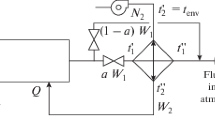The engineering-physical fundamentals of substance synthesis in a boiling apparatus are presented. We have modeled a system of automatic stabilization of the maximum internal heat transfer coefficient in such an apparatus by the characteristics of external flows on the basis of adaptive seeking algorithms. The results of operation of the system in the shop are presented.
Similar content being viewed by others
References
I. Crossland (Ed.), Nuclear Fuel Cycle Science and Engineering, Woodhead Publishing (2012).
V. I. Aksenov, V. A. Nikulin, S. S. Patsira, and V. L. Podbereznyi, The role of evaporators in closed water handling facilities at industrial enterprises, Tsvetn. Metallur., No. 8, 33–35 (2007).
I. V. Kudinov and V. A. Kudinov, Mathematical model of the locally nonequilibrium heat transfer in a body with account for its nonlocality in space and time, J. Eng. Phys. Thermophys., 88, No. 2, 423–438 (2015).
I. I. Gogonin, Influence of the wall thickness and thermophysical characteristics on the critical heat flux in boiling, J. Eng. Phys. Thermophys., 82, No. 6, 1175–1183 (2009).
N. Yu. Tobilevich, I. I. Sagan’, and O. A. Tkachenko, Heat transfer in the optimal hydrodynamic regime of operation of evaporator steam-generating tubes, Pishch. Prom., No. 5, 135–142 (1967).
D. V. Radun, T. A. Kolach, A. G. Levachev, and I. L. Lomakin, On the extreme regulation of electrolytic liquor evaporators, Avtomatiz. Khim. Proizv., Issue 3, 7–14 (1960).
V. M. Zhuromskii, Experimental determination of the optimal operation of the evaporator, Prom. Énerg., No. 8, 46–48 (1979).
M. R. Shabanova, Determination of the thermal diffusivity and nonlocalization parameters from experimental data, J. Eng. Phys. Thermophys., 86, No. 2, 467–470 (2013).
V. M. Zhuromskii and V. P. Ivanov, Automatic concentration stabilization in an evaporator with vertical external calandria, Yader. Fiz. Inzhin., 4, No. 8, 710–713 (2014).
V. M. Zhuromskii, Static Optimization Systems [in Russian], MIFI, Moscow (1978).
V. M. Juromskiy, Energy efficiency optimization of electric drive of gas centrifuges for uranium enrichment, Phys. Procedia, 72, 146–149 (2015).
D. B. Dabney and T. L. Harman, Mastering Simulink 4, Prentice Hall, New Jersey (2001).
V. M. Zhuromskii, N. S. Trushkin, and V. P. Ivanov, Automatic optimization of the heat transfer coefficient in boiling apparatuses, Vestn. MIFI, 2, No. 1, 35–39 (2013).
Author information
Authors and Affiliations
Corresponding author
Additional information
Translated from Inzhenerno-Fizicheskii Zhurnal, Vol. 91, No. 1, pp. 78–85, January–February, 2018.
Rights and permissions
About this article
Cite this article
Zhuromskii, V.M. Controlling the Internal Heat Transfer Coefficient by the Characteristics of External Flows. J Eng Phys Thermophy 91, 72–78 (2018). https://doi.org/10.1007/s10891-018-1720-4
Received:
Published:
Issue Date:
DOI: https://doi.org/10.1007/s10891-018-1720-4



